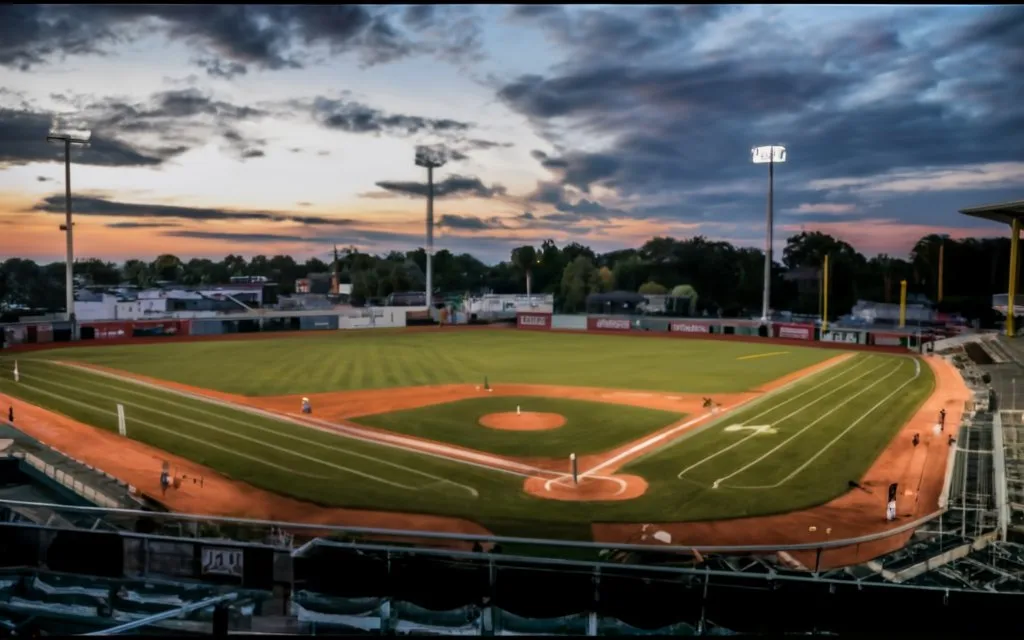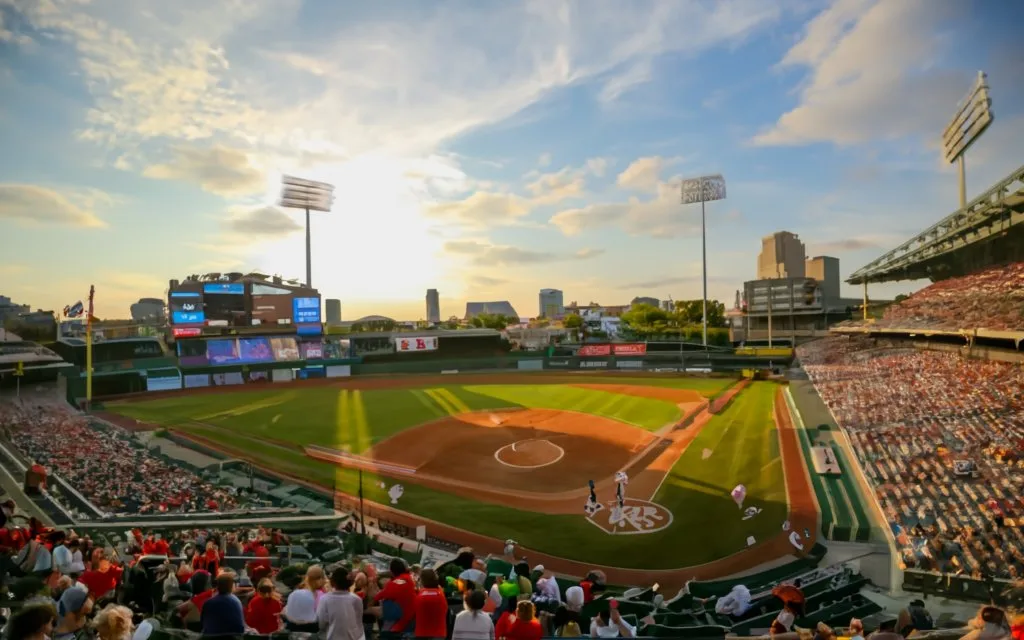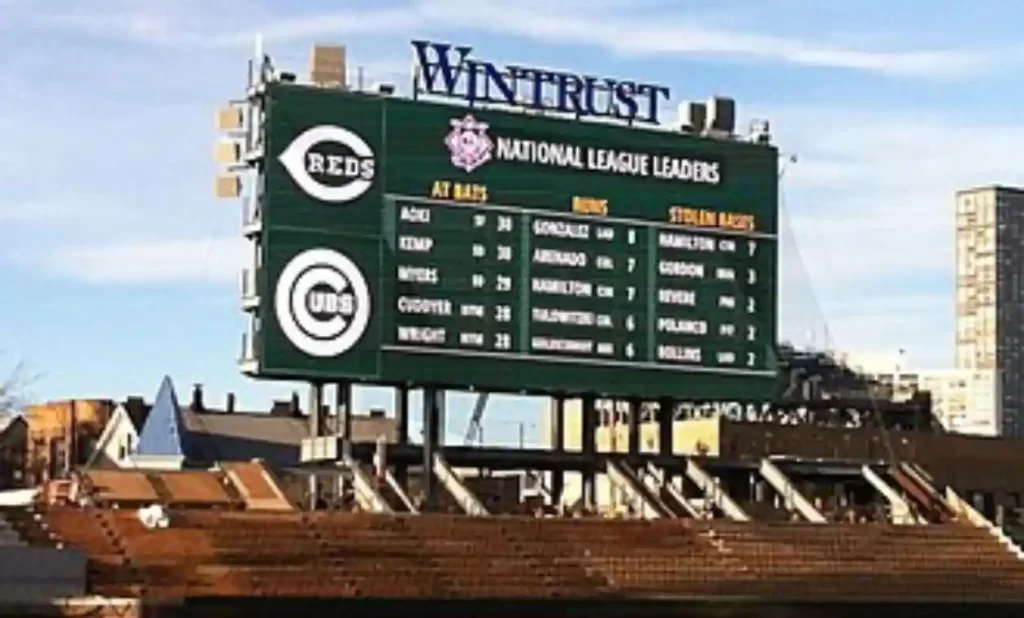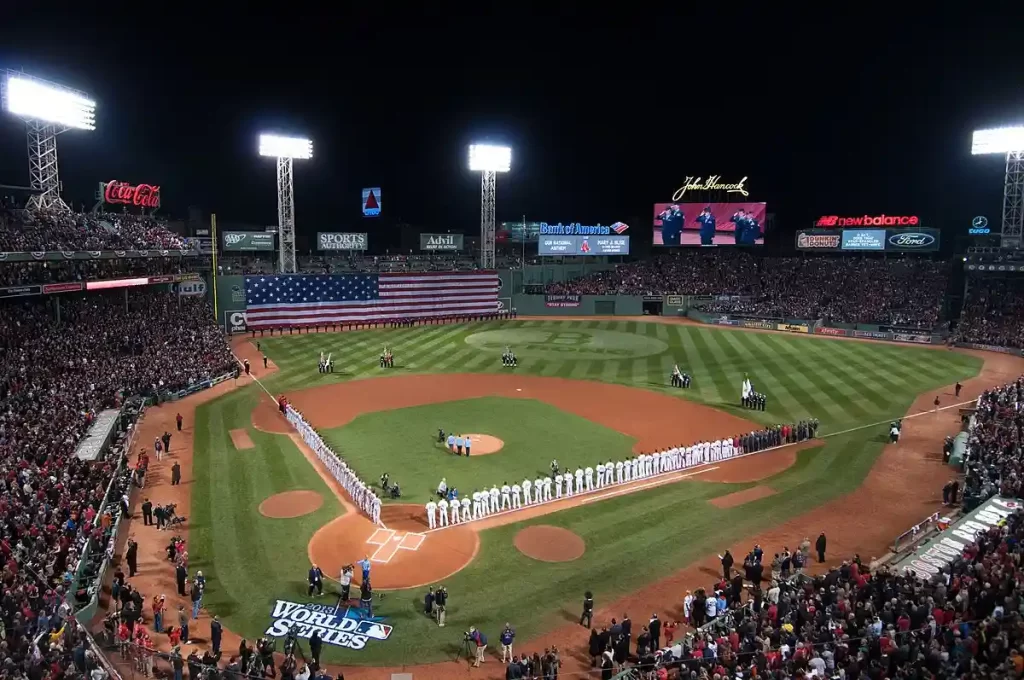
Imagine a sunny summer day at a baseball game. The sun is bright, the fans are loud, and you hear the crack of a bat. Ever thought about the different parts of a baseball field?
There’s the baseball diamond and the pitcher’s mound, the infield and the outfield. All these parts help make the game fair and fun. Knowing about these parts and their details is vital for those who build or look after baseball fields.
Let’s talk about the various parts and details of a baseball field. You’ll gain a better understanding of why baseball is loved by so many.
Key Takeaways:
- Looking into baseball field parts expands our game knowledge.
- Parts like the baseball diamond and the pitcher’s mound each have a job to do.
- It’s key to know about the specs for building and planning fields.
- Every baseball field is made to offer a fair and fun playing experience.
- Come with us to learn about the interesting details of baseball fields.
Safety Considerations for Baseball and Softball Fields
Safety comes first when we make a baseball or softball field. We want everyone there to have fun without worry. That’s why it’s so important to build a safe place for players and fans.
Level Surfaces
Field safety starts with flat ground. Tripping on bumps can hurt players and mess up the game. You must check the field often to fix any hazards.
Padded Barriers and Durable Pads
Protecting players means adding pads to fences and dugouts. These pads soften any hits and lower the chance of being hurt. Remember to check them and replace any that are worn out.
Baseline Fencing
Fences along the baselines keep fans safe from flying balls. They act as a shield. But, they must be strong and looked after to do their job right.
“The safety of players and spectators is our utmost concern. We have installed padded barriers and baseline fencing to enhance safety measures and protect everyone involved.” – John Thompson, Sports Field Manager
Mesh Fencing
Adding mesh fencing helps keep fans safe and gives them a clear view. This way, everyone can watch the game without worry. It’s great for making sure the spectators have a good time.
When making a baseball or softball field, focusing on safety is key. Use flat ground, pads on fences, and proper barriers to keep people safe. These steps help make the field a safe and fun place for all.
Dimensions of Baseball and Softball Fields
Baseball and softball fields come in different sizes for each level of play. Whether it’s tee-ball or high school games, there are set measurements. This is to make sure the game is fair and safe for everyone.
Tee-Ball
In tee-ball games, the bases stand 50 feet apart. This short distance is perfect for young players. It helps them learn the game without it being too hard.
Little League Baseball
Little league fields have the pitcher’s mound 46 feet from home plate. The bases are set 60 feet apart. These dimensions are great for kids moving up from tee-ball.
High School and College Baseball
In bigger games like high school and college, fields are even larger. The bases stretch out to 90 feet. This makes the game more challenging. It also helps prepare players for professional baseball.
Youth Softball
In softball for kids, each base should be 55 feet apart. It’s designed for young players to learn and have fun. The field is just right for their age group.
High School and College Softball
As players get older, softball fields grow bigger. Bases measure 60 feet for bigger challenges. It ensures games are fair among skilled players.
| Level | Base Distance | Distance from Home Plate to Pitching Rubber |
|---|---|---|
| Tee-Ball | 50 feet | – |
| Little League Baseball | 60 feet | 46 feet |
| High School and College Baseball | 90 feet | 60 feet 6 inches |
| Youth Softball | 55 feet | – |
| High School and College Softball | 60 feet | – |
Each level has its own field size to match player skills. This ensures fair play and skill development. Field owners should know these standards to create the right fields.
Acreage Required for Baseball Fields

Building a baseball field starts with knowing how much space you need. This is vital for player safety and a fun game. You must figure out the right size, whether for baseball or softball.
A 90-foot baseball field needs about 4.5 acres. It fits the right angles and distances for the game. There’s room for everything, like the infield, outfield, and extras like dugouts.
On the flip side, softball fields need less. They require a minimum of 1.5 acres with their 60-foot layout. This includes areas for players and smaller paths. But, remember to have space for fans, parking, and other things like food and restrooms.
Thinking about field size is key for the game to run smoothly. Make sure there’s room for everyone, from players to spectators. And following local rules on field sizes is a must.
In the next part, discover how different seating setups can make watching baseball and softball more enjoyable. It’s all about the fans having a great time.
Image: Aerial View of a Baseball Field
Seating Arrangements for Baseball and Softball Fields
Seating is key when planning a baseball or softball field. Creating comfortable places for fans to sit is important. It ensures they see the game well and cheer on their team.
First, you need to think about how many people might come. This includes friends, family, local fans, and those from the visiting team. Knowing this helps figure out how many seats are needed.
Bleachers are a great option for seating. They can fit a lot of people and come in many sizes. For big crowds, you may need several sets of bleachers.
It’s smart to place bleachers where fans can see the game well. Along the sidelines or behind home plate is best. This way, everyone gets a good view.
Keeping spectators safe is also crucial. Adding barriers and railings by the seats helps prevent accidents. It lets fans enjoy the game without fear.
Creating a Comfortable Atmosphere
A comfort zone for fans makes the game more enjoyable. Think about adding things like shade, special seating for those with disabilities, and food stands.
“Creating a comfortable and enjoyable atmosphere for spectators is pivotal in fostering a positive environment at baseball and softball fields. By paying attention to seating arrangements and implementing additional amenities, we can ensure that every spectator has an unforgettable experience.”
Adding special features can attract more people. Seating with more space between rows is more comfortable. This also makes the game available to those with mobility challenges.
Food and drink options, like hot dogs and cold drinks, make the game fun. They help create a community feel at the field.
By focusing on good seating and extra amenities, field owners can make everyone want to come back. This includes attracting and retaining fans.
Water Drainage for Baseball and Softball Fields
Good water drainage is key for baseball and softball fields to stay flat. Without it, fields flood and play can be dangerous. It is crucial to think about a few things for proper water drainage.
1. Playing field grading: The field should be sloped to let water flow away. This stops water from pooling. Experts can help make sure the field is graded right.
2. Choice of construction materials: Materials used for construction affect the drainage a lot. Fields can be made with various materials, each with its own benefits. For example, sand designs help water drain well because sand is porous.
3. Use of sand and gravel layers: Adding layers of sand and gravel helps water drain better. These materials let water through, reducing the need for the water to sit on the field.
4. Consulting field experts: It’s a good idea to talk to experts about field water drainage. They can give advice on what needs to be done for your specific field. Their knowledge can lead to better solutions.
“Having good water drainage is important for safe baseball and softball fields. By doing the right grading, choosing materials wisely, adding sand and gravel, and getting expert advice, you can lower the chances of having water problems.”
By keeping these ideas in mind, you can make baseball and softball fields that handle water well. This creates a safe area for players. Let’s now see visuals of various construction types and how they handle water drainage.
Water Drainage Comparison – Different Field Construction Designs
| Field Construction Design | Water Drainage Rating |
|---|---|
| Native soil | Poor |
| Modified native soil | Moderate |
| Sand-based | Excellent |
| Synthetic turf | Excellent |
The table explains how various field materials affect water drainage. Fields made with sand or synthetic turf drain water well. On the other hand, native soil and modified native soil designs might struggle. When planning a baseball or softball field, consider these details for better drainage.
Expert Advice for Baseball Field Construction
Starting a baseball field project? It’s key to get help from experts. Field consultants, installers, surveyors, and soil analysts are crucial. They guide you to make smart choices and lead you through construction.
Field Consultants and Professional Installers
Field consultants and installers bring a lot to the project. They know a ton about building baseball fields. They can help with choosing the right location, safety, making sure water drains well, and picking the best materials. Getting advice from these experts will ensure your field does well.
Qualified Surveyors and Soil Analysis
A good surveyor is a must. They check the land and make sure the field’s size is right. They help with getting the soil ready to be used. This is important for choosing the best ways to handle water and which materials to use for building. Doing this makes the field last longer and work better.
The Construction Process
Building a baseball field is a big project. It goes from planning to the final touches. experts’ advice is vital at every stage. Consultants and installers guide you through preparing the land, making it level, adding the playing surface, setting up water systems, and planting the grass. They make sure everything is done well, leading to a top-notch field.
“Talking to field consultants, installers, surveyors, and checking the soil are steps you must not skip. Their know-how and direction will make your field safe, perform well, and last long.”
By working with skilled pros and tapping into their wisdom, your field project will be well-planned, done right, and detailed. This partnership will create a standout baseball field. It will meet all standards and offer a great experience to everyone on and off the field.
Equipment and Materials for Baseball Field Construction
Building a baseball field needs key equipment and materials. They are vital for player safety and to make the field work well. It’s key to pick the right things for your project, such as:
- Bleachers: Making sure there’s good seating is important. Bleachers give a spot for fans to watch and cheer. Think about how many people will watch and choose bleachers that fit.
- Bases: Bases mark out the field and guide players. They are placed to make the diamond shape where baseball is played. Top-quality bases are needed for a great game that’s safe.
- Fencing: Fencing does a lot – it marks the field, stops people from going where they shouldn’t, and keeps everyone safe. Plus, it can add beauty to the field.
- Netting: Netting is essential in indoor areas to keep balls in a safe space. The right netting makes practice safer and more focused.
- Dugouts: Dugouts are where teams wait. They offer cover and a view of the game. Good dugouts mean happier players.
- Field Maintenance Equipment: Keeping the field nice is a must. Things like tarps and rakes help with field care and make it last longer.
Don’t forget these tools and materials when planning your baseball field’s budget. Setting aside money for top-notch, long-lasting gear is crucial. It ensures your field will be enjoyed for years to come.
Expert Tip:
“Choosing safe and durable gear for your baseball field is key. It’s an investment in the well-being of your players and the field’s future.”
Cost Considerations for Baseball Field Construction

One of the main things to think about when building a baseball field is the cost. The price can change based on why you’re building it, how big it is, and what special features you want. This includes things like seating and amenities.
Reducing costs
Trying to save money without making the field worse is what many people aim for. There are a number of ways to cut costs on baseball field projects.
You might save money by picking between real grass and artificial turf. Real grass needs care and water, while artificial turf is costly upfront but cheaper later on to maintain.
Consider using portable fencing to help save. It’s flexible, can be moved easily, and doesn’t need the cost of installing fixed fencing. This can save a lot of money on your project.
Also, how often the field will be used affects your costs. If it’s just for the occasional game, a simpler field design with fewer extras might be all you need. But for a field used often by professionals, you may want more.
Setting a budget
It’s very important to know your budget before you start building. Setting this early helps you spend wisely and avoid money problems later on.
Talk to experts to figure out costs for everything you need. This way, you can plan your budget properly and not be surprised by extra expenses.
By picking smart ways to save money and setting a clear budget, you can make the most of what you have. This will lead to a successful baseball field project.
| Cost Considerations | Strategies |
|---|---|
| Choosing between real grass and artificial turf | Compare initial costs and long-term maintenance expenses |
| Opting for portable fencing | Evaluate the need for permanent fencing and consider the flexibility of portable fencing |
| Considering the frequency of field use | Adapt the design and amenities based on the expected usage of the field |
| Setting a budget | Consult with experts to get accurate cost estimates and allocate resources effectively |
Conclusion
Building a baseball field needs a lot of thought and planning. Safety is key. Make sure the ground is even and there are safe barriers. It’s important to choose the right field size for the type of baseball being played.
Getting advice from professionals and using good equipment is vital. This includes hiring experts, testing the soil, and picking the best tools and materials. Money is also a big factor. You’ll need to decide things like real grass or fake grass and how to save on costs.
By following these steps and getting expert advice, you can make a great baseball field. It will be safe and fun for both players and fans to enjoy.
Recommended
- BASEBALL FLOW HAIRCUT: TRENDY STYLES FOR ATHLETES
- WHY ARE BASEBALL BATS SO EXPENSIVE? UNRAVELING COST
- REGRIP BASEBALL BAT: EASY STEPS FOR BETTER PERFORMANCE

Meet Daniel Anderson, the heart and soul behind Baseball Pro Picks. At 49, Daniel’s life has revolved around baseball, a passion that’s as strong today as it was when he first fell in love with the game. Living in the USA, Daniel has dedicated countless hours to watching, analyzing, and understanding every pitch, hit, and home run, making almost no game missed. His deep-rooted love for the sport is matched only by his commitment to sharing insightful, expert analysis with fellow baseball enthusiasts. With decades of experience and a keen eye for the game’s nuances, Daniel brings a unique perspective that enriches Baseball Pro Picks. Trust Daniel to guide you through the intricacies of baseball with the authority and trustworthiness of a true aficionado.












